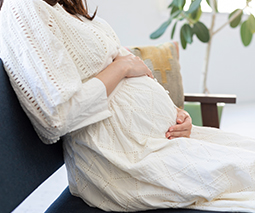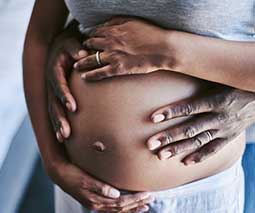Spotting and cramping in pregnancy: What you need to know

Spotting and cramping are a normal part of pregnancy for many women. In fact, a quarter of all mums-to-be are said to experience it – and these mums go on to deliver babies at full term. Still, it’s scary when it happens as it can also be a sign of miscarriage.
Here is what you need to know and when you should call your doctor.
What is spotting?
Spotting is light bleeding from the vagina. While it often occurs during the first trimester, as your tiny baby disturbs the lining of your uterus, some women continue to experience it throughout their entire pregnancy.
Although common during pregnancy, you should let your doctor or midwife know if you experience light spotting for longer than a day. As they’ll want to know the type of bleeding you’re getting, you’ll need to monitor the amount of blood loss you’re experiencing, including what it looks like. You can do this by wearing a pad (not a tampon) and then checking it over time.
If the blood is faint, an intermittent flow, and smaller than a coin in size, it’s less of a concern. Heavier bleeding that can indicate a miscarriage however, is usually dark in colour and may have clots or clumps of tissue in it.
You should also tell your pregnancy care provider immediately if the bleeding is accompanied by fever, pain, and/or chills.
What is cramping?
Cramps are a spasm in the front or back abdominal muscles. While mild cramps during pregnancy can be uncomfortable or even slightly painful, they are also bearable.
If the cramping is sharp, not letting up and your muscles feel taught, then it could be a sign of premature labour, or another pregnancy complication.
What does it mean when both happen together?
When bleeding and cramping occur together, a visit to your obstetrician is warranted as this can sometimes be a sign of miscarriage.
Unfortunately, miscarriage does occur in 15 percent of pregnancies. While it usually happens in the first trimester, it can happen at up to 20 weeks gestation. Bleeding after this time is usually associated with other complications in later pregnancy, such as placental abruption, placental previa, pre-eclampsia and/or preterm labour.
When you see your doctor, she’ll check things like your baby’s heartbeat, your hCG levels and check your baby’s growth via an ultrasound.

Other possible causes
While miscarriage is, understandably, every pregnant woman’s worst fear when she sees some blood in her underwear, there could be other reasons for your spotting and cramping. These include:
- Implantation bleeding – this occurs often during the first two weeks after conception. This type of bleeding should be faint, like coloured discharge.
- Ectopic pregnancy – this happens when the embryo is implanted outside of the uterus, usually in the fallopian tubes, but sometimes in the ovaries, cervix, pelvis or elsewhere. If you’ve already had a scan and everything was fine with your baby’s positioning, then you can rule this one out as the cause of your bleeding and or cramping.
- Baby’s growth – as your uterus expands, you can experience cramping. This type of cramping is most common in the first trimester.
- Sex – minor vaginal bleeding can sometimes be caused by sex. You may also experience cramps after sex thanks to hormones that are released causing your uterus to contract.
- Molar pregnancy – this is rare but happens when the fertilised egg’s cells don’t grow in a way that can support a pregnancy. In a molar pregnancy, there is no baby and no heartbeat. Again, an ultrasound will rule this out.
- Infection – sometimes an infection such as a urinary tract infection can cause blood in the urine. If you suspect you have an infection, seek treatment as this can cause premature labour.
- Sub-chorionic hematoma – this type of bleeding does have the potential to lead to miscarriage, and can be detected with an ultrasound.
Of course, pregnancy may not be the cause of your symptoms at all. Sometimes, other medical conditions such as kidney stones are the culprit, which is why a visit to your doctor is always a good idea.
Bleeding in late pregnancy
In the final weeks of pregnancy, a discharge that is pink or bloody could be a ‘show’ – which is an indication that labor will start soon. A call to your midwife or doctor will confirm your suspicions and you’ll get instructions of what to do next. Rarely, it might be a sign of an obstetric complication.
When to see your doctor
Few women go through pregnancy without a scare (or two!). If you are experiencing any bleeding and/or cramping, then the advice is to always tell your doctor. A quick phone call is often all it takes to ease your mind.









